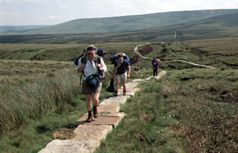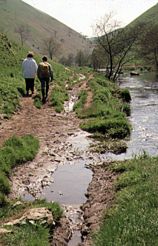
|
|
Principle 3; Manage Wilderness and Sites within, under a Non-Degradation Concept. |
Banff National Park

The majority of the park has not been degraded by human activities. Some specific examples of areas that have been significantly affected are the Cascade and Spray Valley wildlife corridors and the major ski areas. Under the Management plan these areas are being restored by the following methods:
Cascade Wildlife Corridor - removal of the airstrip, horse corral and Army Cadet camp
Spray Valley Corridor - mostly affected by the Banff Springs Golf Course. The course will see no further expansion or modifications that may affect the migration of the animals
Ski Areas - Mt. Norquay, Skiing Louise and Sunshine. Close attention to the use of ski areas, not further construction is planned and summer use of the lift is prohibited
Peak District National Park
The role of various industries within the park, essential for its well being result in an environment where degradation is unavoidable. The PDNP has recognised the impact of footpath erosion and the loss of biodiversity within the park in recent years. Numerous management strategies have been actioned with the appropriate players consulted in order that the effects can be mitigated against and the park's qualities promoted and protected. This has included;


It is important to remember that the PDNP is a working and living park and as a result of this it is not feasible that it is non-degrading.
|
|
Principle 4; Manage Human Influences, a Key to Wilderness Protection |
Banff National Park
Human influences include fire suppression. This has been shown to affect the vegetation with non-native species dominating especially fire resistant species. Prescribed burns have been organised to control the problem but this is very costly and has been shown to not be effective in mimicking a natural burn.
The removal of certain campsites, for example Carrot Creek in the Fairholme range which is a large area of montane forest. Also trail management is used to reduce human impact, with the seasonal closure of some trials.
No motorised transport is permitted within the park boundaries except on the highways, to reduce the number of incidents, some roads, for example Highway 1A has been permanently closed in sections and the western section of the loop road to Lake Minnewanka is closed in the winter months
Peak District National Park

The recognition of climate change as a human induced effect, affecting the PDNP is a good representation of the forward and wide ranging appreciation of the PDNPA’s response to the management of human influences. Climate change will have dramatic effects upon species distribution and biodiversity in the park. Winters are likely to be come wetter and summers drier with influential effects upon activities within the park. The PDNPA is taking the issues seriously and it’s integration and enthusiasm for sustainability is ensuring that the park is acting in a responsible way in order to reduce the effects of climate change. This has included the promotion of alternative transport and walking and cycling as sustainable, environmentally friendly and recreationally beneficial solutions.